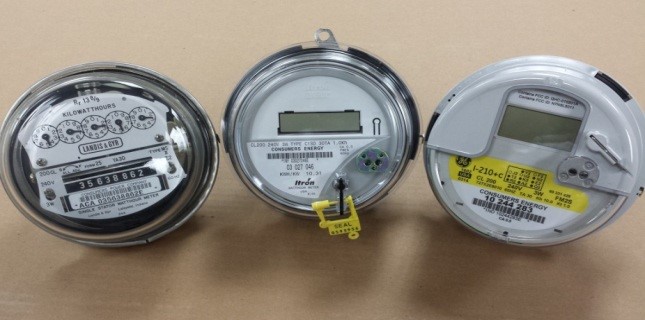By NYLA HUGHES
Capital News Service
LANSING — Utility companies across Michigan are using digital smart-grid meters to locate power outages, resolve power problems and gather more accurate readings.
The meters at homes and businesses are connected by a cellular power line to the utilities. The utilities can signal a meter for information and it will send data back.

Smart meters: Credit: Consumers Energy
But the meters aren’t without controversy.
During a recent House committee hearing, some lawmakers raised concerns that the wireless communications that smart meters use pose a health risk State regulators say those concerns are not conclusive.
Some residents are also concerned they cannot opt out of installing the meters without paying a hefty fee to the utility.
Smart meters are a growing phenomenon.
In August, Consumers Energy rolled out a plan to install 1.8 million smart meters in homes and businesses by 2017. The meters tell the company how much energy is used, avoiding the need to estimate bills, said Dennis McKee, the company’s communications director.
By 2016 the meters will let the company launch a program to let customers buy cheaper electricity when they use it during off-peak times, McKee said.
“People who use most electricity at night can enroll in the program and end up saving some money,” said McKee.
However, if customers purchase more electricity during on-peak times, they’ll want to stay on the standard rate program so they won’t end up paying more, he said.
The Lansing Board of Water and Light recently installed 140 smart meters for East Lansing residents, many of them Michigan State University students who typically leave in the winter for the holidays. Smart meters are helpful in that situation because they can alert the utility of power outages even when a residence is vacant.
About 40,000 people in Lansing were left without power for an extended period during an ice storm last winter, said Stephen Serkaian, the board’s director of communications. The meters can signal the utility as soon as power is lost.
“They signal the utilities when there is a power outage without having to wait for someone to report it,” said Serkaian. “With smart-grid meters, response time for restoration of power can improve.”
Homeworks Tri-County began using smart meters in 2008 for approximately 26,000 residents and businesses in Barry, Clare, Clinton and Eaton counties. The installation eliminated the need for someone to read meters, said Mark Kappler, the general manager. Some readings were inaccurate under the previous system because the meter reader entered the wrong data.
The company saved money, too.
“We serve a rural area, so driving from meter to meter was costly,” Kappler said.
The meters also measure voltage levels that can track such things as how often the lights dim, he said. The utility can immediately diagnose such problems, a smart metering benefit that customers appreciate the most.
“When someone has reliability issues, the meters record the outages over a period of time,” Kappler said. “If their lights are dimming, they have a quality issue.”
Rachel Johnson, grassroots advocate for Cherryland Electric Cooperative in Traverse City, said the utility’s 33,000 customers can use an online app to monitor power use because of their smart meters.
“The app, Smart Hub Account Management, allows them to see how much energy they’re using and compare it to temperature data,” she said.
Customers can quickly discover if the temperature set on their thermostats costs them more than they can afford. If so, they can lower their thermostats to a price they can afford and put on a sweater.
“The customer has control over how much energy they use, pay their bill down and make lifestyle changes accordingly,” said Johnson.
Johnson said the switch to smart meters is paying off.
“We are recovering more revenue because we’re getting accurate data directly from the meter immediately,” she said. “We know we are billing for the exact amount used.”